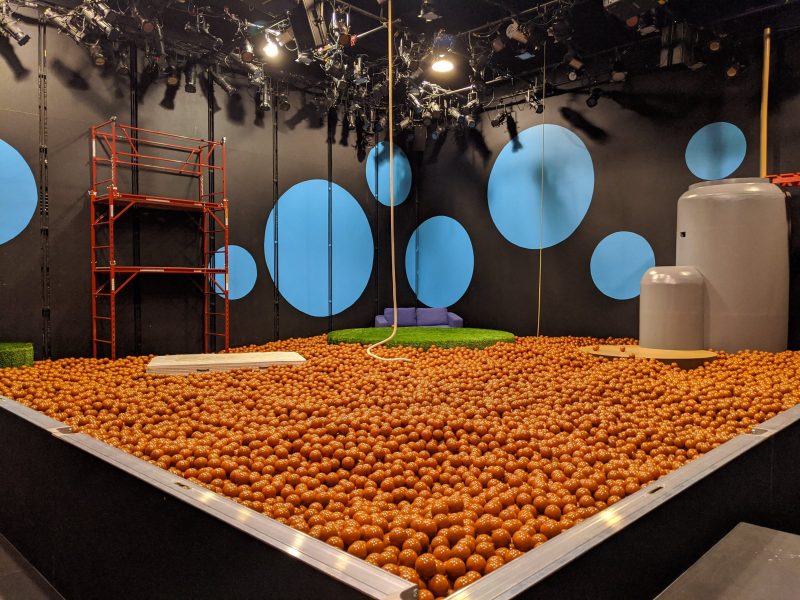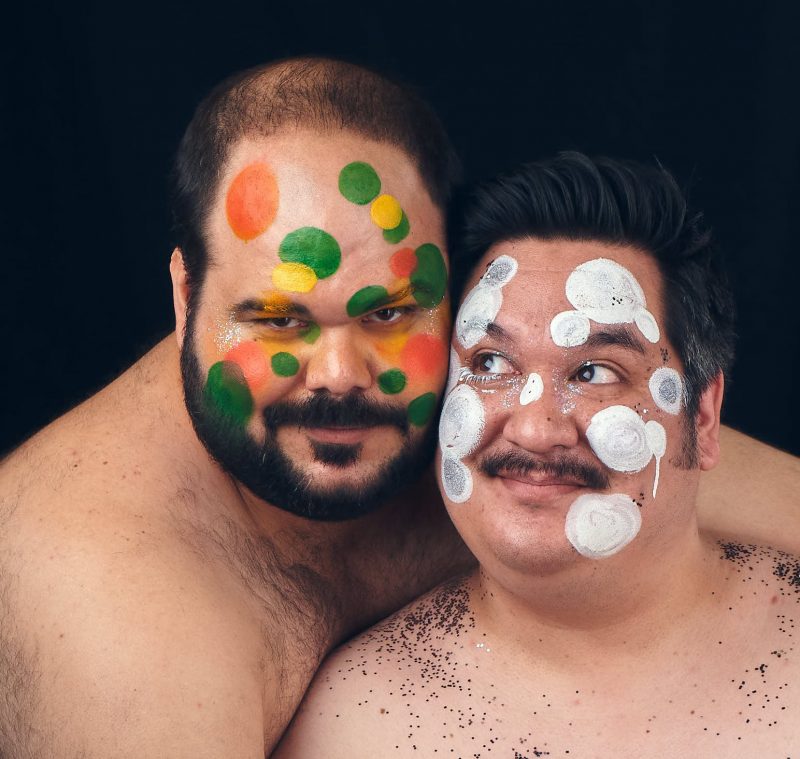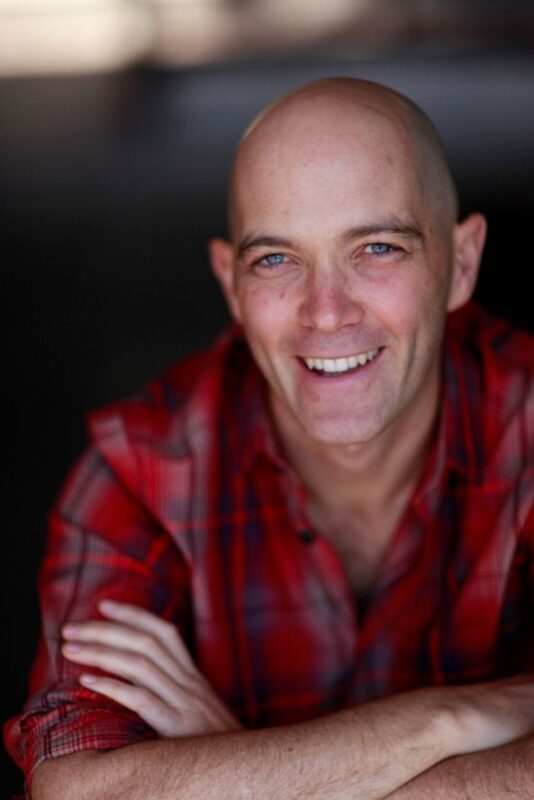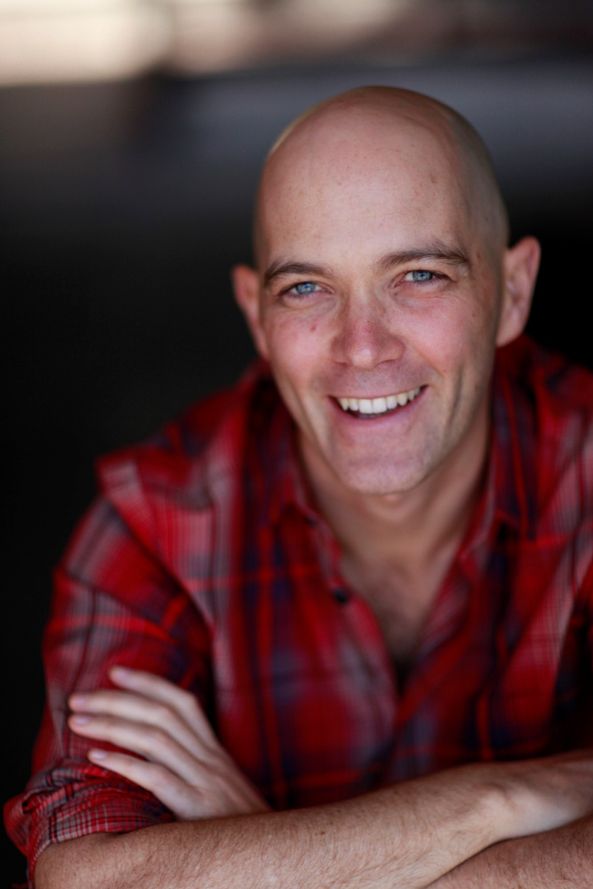TYA/USA spoke with Taylor Mac and director Niegel Smith (The Flea’s Artistic Director) about the theatrical use of ball pits, the connection between TYA and drag performance, and the urgency of telling stories to young people in new ways. (Learn more about THE FRE here, running February 28 to April 12 at The Flea Theater in New York City.)
In Conversation With
How did THE FRE come to be? How has the piece evolved over the course of its development?
-

Well it’s part of four plays that I’m writing which deal with America’s polarization. Gary is one of them, Hir is the second, The Fre is the third, and a play that hasn’t been produced yet, called Prosperous Fools, is the fourth. I try to tackle it from different angles. One of them from love (The Fre); one from economic disparity (Prosperous Fools); Gary is internal liberal polarization between polarized camps; and Hir is through the family. I wanted to write a dionysia which is four plays. The Greeks would perform four plays all in one day and usually they would be three tragedies and a comedy. I thought, why don’t I write three comedies and a tragedy? The Fre is one of the comedies and it really has a lot to do with just growing up in Stockton, California and never wanting to be there and always wanting to leave, then finally escaping and looking at America and thinking, if everybody leaves the horrible places do they change? Do those places need us? Is that condescending?
I got invited to go to a silent retreat in Texas through New Dramatists and while I was there I was surrounded by Texas and nature and a swimming hole and I thought: Let me write a play about this!
For me the content always dictates the form so I said: I’m talking about this place that I used to live as a child. I don’t live there now as an adult. So let me grapple with those youthful feelings. It just seemed like it would be right to invite younger people into this experience. They’re always invited to my shows but most of my shows I don’t usually censor cursing or sexual situations, so it’s always like, come at your risk! But with this show I definitely considered that kids would be in the audience. I framed things a little more for a younger audience that can’t always contextualize on their own.
It was not always in a ball pit. It was set in a mud pit. I think that’s why it’s taken so long to be produced. Although people say it’s the money, and that rarely is the reason. Filling your theater with mud was really intimidating for the people that commissioned it originally and for any theater. Niegel said yes and we were just going to do it, but the ball pit was a creative solution to the economic and logistical problem of filling your entire space with mud. Also it never sat right that I was asking an audience to sit in mud for 70 to 80 minutes. It’s fun for 20 minutes and then you want to clean off. I didn’t want to shorten my play so I was always grappling with that. I don’t want them to get rashes! Nor do I want the actors to get rashes. So it was creative thinking and we’re in the theater so why don’t we use metaphor to solve the problem. And I think it was also a push from Carol Ostrow, The Flea’s producer, to use metaphor. I was kind of resisting it and saying: Why can’t we just try this? And then when I actually really thought about it I thought it would actually be more fun in a ball pit.
"For me the content always dictates the form so I said: I’m talking about this place that I used to live as a child. I don’t live there now as an adult. So let me grapple with those youthful feelings. It just seemed like it would be right to invite younger people into this experience."
— Taylor Mac

Why is this piece being presented for young audiences? What do you think it has to say to young people today?
-

Last night I was hanging out with a mom and her daughter and they were having two very different experiences. The mom was like: we are at a house with two adults, we are going to have an adult experience. The child was like: I’m a kid, let’s have a kid experience. It was this great microcosm of how we sort of separate ourselves in how we experience life and how we experience theater. Suddenly you turn 16 and you’re supposed to sit still and receive a thing and then talk about it afterwards. So one of the things I love about this piece is that it asks all of us to stretch towards a sense of play and embodiment and being and sharing together across ages.
-

I was never really interested in it being just for kids. I had this wonderful experience in A Midsummer Night’s Dream where there were a couple young audiences and it was all kids. They treated us like we were rock stars. And they laughed and they screamed and it was the most live that the production ever became. I was thrilled by it. It was almost like doing my drag shows. It was that kind of energy in the audience. It was so much fun. I thought can I take my audience that normally comes to the performance art stuff and this audience of young people and smush them together and see what happens. That’s the hope. Get ‘em while they’re young!
The main catalyst was: What kind of play would I want to see when I was 13 that I wasn’t allowed to see? So that’s what I wrote. I can’t say that when I was 13 I would have been able to articulate that I wanted to see a play like this. I probably would have been embarrassed to say that. I thought let me just write that play. It’s so wonderful being a theater artist or a creative person because you get to manifest the world that you want. I would like there to be a play in the world that I would’ve liked to see when I was 13 and you just write it and you get together with people and you make it. So that’s the joy of this life that we’ve chosen.
I would say that young people were first and foremost in the consideration in the play and the writing and the way that it presented. I wanted adults to be able to come to the experience and feel like they weren’t doing time with the kids. That actually this was a play for them as well. I was juggling both of those things at the same time. You know how Pixar and Disney films are like, “Oh adults can enjoy it too!” And that’s not what I was going for–the thing where we infantilize adults. My experience with kids is that they really want to talk about ideas when you really get into it with them and they are really interested in philosophy, and how the world works, and why things are happening the way they are. They have a real passion for that once you break through the social barriers. The problem that I see with adults is that they just want to be entertained or confirmed.
My experience with kids is that they really want to talk about ideas when you really get into it with them and they are really interested in philosophy, and how the world works, and why things are happening the way they are. They have a real passion for that once you break through the social barriers. The problem that I see with adults is that they just want to be entertained or confirmed.
So I thought, why don’t we center the kids? I was concerned with the kids first and I wanted to make sure adults could hang out with it. It’s a smarter play than what most adults go to in the American theater. And it’s a sillier play than what most adults go to in the American theater.
-

When I think about it for kids I think kids learn “yes” and they learn “no” and then they learn “why”. So much of theater for young audiences is about, “Yes, do this,” and “No, don’t do this,” but very little of it is about, “Why? Consider. Think.” This play assumes that young people also want to ask questions and think about the world and not know all of the answers. I think it’s sophisticated in that way. Or assumes the sophistication of its audiences.
-

Little kids might not get some of this stuff but they will have fun because it’s goofy. And older kids are going to want to talk about the ideas in the play. That’s why I wrote it!
"Suddenly you turn 16 and you're supposed to sit still and receive a thing and then talk about it afterwards. So one of the things I love about this piece is that it asks all of us to stretch towards a sense of play and embodiment and being and sharing together across ages."
— Niegel Smith

THE FRE at The Flea Theater. Photo courtesy of The Flea.
Why do you think it is important to share new stories with young audiences and expand the canon of TYA in the US beyond recognizable titles?
-

We can’t allow our entire culture to be dominated by commerce. That’s telling a very specific story that I don’t think is the whole story or very useful to raise children in. I don’t think it’s good to raise children with homogeneity of style and genre and form and content. I think one of the reasons we have a tribe mentality is because every single story we tell is the same thing told in the same way. We have to figure out a way for people to engage in culture that isn’t about trying to win dollars. What is the viscous thing about most children’s theater as done is that it has commodified the relationship between the kid and the world or the relationship between the world and their parent. Underoos were sold at the grocery store because that was when the kid was going to be with the parent the most. The kid wasn’t going to be at Macy’s or Sears with their mom necessarily as they were in the grocery store. So they sold the Underoos at the grocery store because they knew the kid would go, “Mom, buy me those!” So they commodified the relationship between the kid and the parent. There is a certain cynicism in that I find really unhealthy for our culture.
Of course we need stories outside of commodification. Because we need surprise too! That’s all a very wordy way of saying we also just need surprise. We need to be surprised by seeing things that we’re not used to. If we’re always seeing the story about the princess that gets rescued, or even the “strong female lead” princess that conquers the world—how many times can you watch that story before going, “OK, can we talk about something else in this world?”
-

The way we do poop is sophisticated! I think its to our detriment that our culture doesn’t include more of the tomfoolery part of human experience. We all poop. We all fall down. Life is absurd. And that’s funny and we should lean into that. And the pleasure of jumping in a pit of balls and clowning around with friends—that is as worthy of our attention and making as the ideas that are inside of the play. One of the most interesting questions inside of the play is how much can you sustain either? Where do they blend?
-

That’s a major conversation in the play—how ridiculous humor in the play and farts and burps and being wild and crazy can coexist with theory and poetry and ideas about the world.
-

I’m 40 years old and at home we’re talking about the political state of our country, but we’re also farting and making fun of each other! Both of those things exist.
"We can’t allow our entire culture to be dominated by commerce. That’s telling a very specific story that I don’t think is the whole story or very useful to raise children in. I don’t think it’s good to raise children with homogeneity of style and genre and form and content."
— Taylor Mac
We hear the show takes place in a ball pit! Can you talk about the design of the show and the unique nature of the staging?
-

First of all, 80% of the theater is the ball pit. We are literally flooding the theater with balls. The actors perform inside of the ball pit and a few on raised platforms.
-

It’s the largest ball pit you’ve ever seen.
-

Yes. And some audiences can sit outside, but they get balls too to throw and balls get thrown at them. It’s a really fun challenge because it opens up different kinds of comic bits and appearances and disappearances and swimming, but it’s also a challenge. We’re discovering how sound works inside this many moving balls and how audiences work inside of it.
-

It’s so much fun though. I’ve never seen a play that allows for this level of physicality because the balls protect you. So you can really jump into them and you don’t have to worry about how to fall properly because the balls protect you- it’s like jumping into water. SO that’s just fun and opens up so many different things you can do.
-

There’s tumbling, climbing, rope swinging, diving in the balls.
-

I mean just the pop up jokes!
How does THE FRE fit into the overall strategy and new focus on young audiences at The Flea?
-

It’s our most ambitious theater for all ages that we’ve taken on and is really given the full might of The Flea behind it. To have Taylor here in residence making this play is a real gift for audiences and our residence artists. The attempt was to say that theatre is for everyone and from a very early age you deserve sophisticated, original storytelling that acknowledges you as a creative and sophisticated person. It just makes sense.
Why do you think it is important for a venue that is serving adult audiences expand their programming to include children and families as well?
-
Because it’s ageist, number one! I mean, I’ve worked in these places that say, “Oh, we don’t do theater for children,” as though children don’t matter! As if they’re not worthy of our time and energy and resources. There are so many sources of stories and media, that—guess what? If you don’t serve them and invite them into live performance at an early age, they may not choose to be a part of theater, which I think is a pretty fabulous form.
-

We’ve chosen a form for this play that is different than any other play that people have seen. I’ve seen mud onstage before; I’ve never seen a play set in a ball pit before. So that is a really unique experience. What I know is that as a kid, when you have a unique physical experience like swinging on a rope swing into a lake, you don’t tend to forget it. It stays with you. So that’s why it was important to me to create a play with kids in mind that would give them a visceral, physical experience that they could take into their adulthood and think, “Oh, that amazing time I had playing wasn’t on a playground or a swimming hole or a theme park, it was in the theater!”
-

I can’t wait for my nieces and nephews to come. They’re gonna be like, “You do this for a living?!”
-

It’s just acting a fool while at the same time thinking. Can we think and act a fool at the same time?
-

This is always true of Taylor’s plays, but it’s a total piece of theater. There’s movement, there’s dance, there’s music, there’s text, there’s non-text moments, there’s clowning, there’s- very briefly- serious scenes! It’s all there.
-

The actors are really wonderful physical actors.
-

It is going to be incredibly enchanting. When you see these actors in that make up and in those costumes by Machine Dazzle in this ball pit set surrounded by these circles everywhere, you’ll be like, “Where am I? Whoa!”
-

You’ve never seen a world like this. We’re trying to create a world you’ve never seen before.




